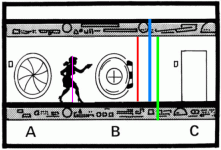snrdg082102
SOC-14 1K
Hello all,
T4 Book B FF&S pp. 12-13 provides the guidance for installation of jump drives for starships. The jump drive table in T4 Book B FF&S appears to have been directly imported from TNE FF&S page 42.
TNE FF&S p. 42 calculates the surface area required by the jump drive, per T4, grid using the equation Grid Area (m2) = Jump Drive Volume in cubic meters ÷ 3.
T4 Book 2 Starships SSDS p.10 uses the same equation as used in TNE FF&S.
In T4 Book B: FF&S the Jump Grid Area found by using the total surface area of the hull. Each hull shape alters the surface area of the hull which alters the surface area covered by the grid. Unfortunately, T4 Book 1 QSDS and T4 Book 2 SSDS standard Jump Drive Tables will not match T4 Book B Equation 3: Jump Grid Area = Total Area x 0.005 x (2 + Jn) for the hull shapes since they both use jump drive volume not the total surface area.
Can anyone translate the following rules to something I can understand:
T4 Book B p. 12
"The amount of energy required to initiate a jump is equal to 64MJ per cubic meter per parsec jumped. This energy must be provided to the drive in an hour or less (meaning that a starship must have 0.018MW of power plant per cubic meter per jump number)."
"Once in jump space, the jump drive maintains a small bubble of real space around the ship, using power input to the jump drive from the power plant (0.018MW of power plant per cubic meter per jump number)."
I believe the above implies that a power plant installed on a 100 displacement ton (TD) hull capable of jumping 1 parsec must have a minimum output of 19.6 MW to provided the 89,600MJ of energy to initiate the jump.
T4 Book B FF&S pp. 12-13 provides the guidance for installation of jump drives for starships. The jump drive table in T4 Book B FF&S appears to have been directly imported from TNE FF&S page 42.
TNE FF&S p. 42 calculates the surface area required by the jump drive, per T4, grid using the equation Grid Area (m2) = Jump Drive Volume in cubic meters ÷ 3.
T4 Book 2 Starships SSDS p.10 uses the same equation as used in TNE FF&S.
In T4 Book B: FF&S the Jump Grid Area found by using the total surface area of the hull. Each hull shape alters the surface area of the hull which alters the surface area covered by the grid. Unfortunately, T4 Book 1 QSDS and T4 Book 2 SSDS standard Jump Drive Tables will not match T4 Book B Equation 3: Jump Grid Area = Total Area x 0.005 x (2 + Jn) for the hull shapes since they both use jump drive volume not the total surface area.
Can anyone translate the following rules to something I can understand:
T4 Book B p. 12
"The amount of energy required to initiate a jump is equal to 64MJ per cubic meter per parsec jumped. This energy must be provided to the drive in an hour or less (meaning that a starship must have 0.018MW of power plant per cubic meter per jump number)."
"Once in jump space, the jump drive maintains a small bubble of real space around the ship, using power input to the jump drive from the power plant (0.018MW of power plant per cubic meter per jump number)."
I believe the above implies that a power plant installed on a 100 displacement ton (TD) hull capable of jumping 1 parsec must have a minimum output of 19.6 MW to provided the 89,600MJ of energy to initiate the jump.

